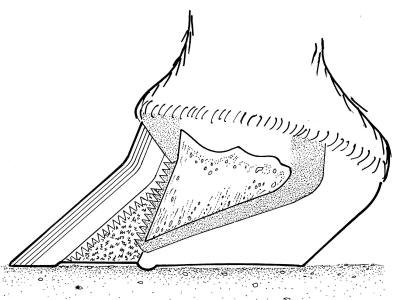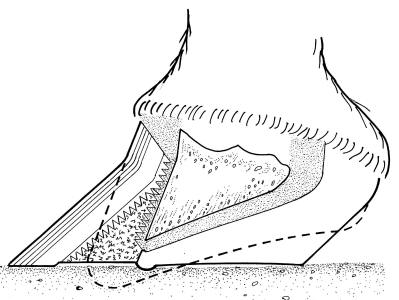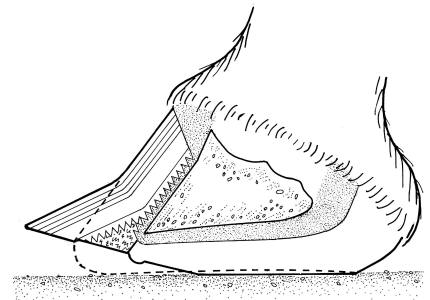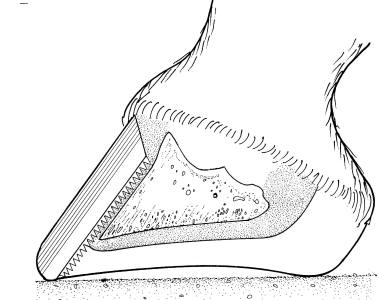
Horseback Magazine—Pete Ramey #2
4-10-2013

A: This is a very common (but serious) problem. You should get lateral radiographs to confirm this, but I think you should instead be trimming the heel and leaving the sole alone at the toe. Look at your horse’s hoof from the side with your chin at ground-level. Do you see that the upper wall growth close to the coronet (hairline) is steeper than the wall growth at ground level? The wall growth at the hairline is probably better-connected and more parallel to the coffin bone—with the lower wall growth separated or rotated away from the bone (see figure 2). Most of the time, when people feel the need to “stand a horse up” they have encountered a problem like this.

When hoof capsules are flared or
rotated away from the bone, the tip (front or apex) of the frog will appear to
be too far away from the toe because the frog grows
from the under-side of the bone. The
white line may appear normal, even
with significant rotation present. This is because the material produced between
the coffin bone and the hoof wall (lamellar wedge) can look much like the sole.
Drawing by Karen Sullivan from the book
Care and Rehabilitation
of the Equine Foot, P. Ramey, Hoof Rehab Publishing, 2011.
The dashed line in figure 3 represents a normal hoof as it should surround the coffin bone. By studying this drawing, you should be able to see why I suggested that you might be going about this backwards (by trimming sole at the toe and leaving the heels alone). In the drawing, the heels are higher than they should be, while the sole at the toe is dangerously thin. Since there is too much material in the back of the foot, and not enough in the front, this also means there is one area in-between that is just right. Be careful not to trim the area that is already correct. This means that as you lower the heels, there will be a rockered appearance to the back of the foot.
Caution: If the sole is as
thin as these drawings suggest, special care must be taken not to bruise the
sensitive tissues. Don’t let the horse walk barefoot on hard terrain. For horses
in this condition, I tend to use hoof boots with foam-rubber insoles, but many
devices will work—from elaborate shoeing packages to simple taped-on padding.

A typical
rotated hoof capsule. The dashed line
represents the location of a normal
hoof capsule surrounding the bone. If this idealized foot were cultivated, the
frog would be much closer to the toe, the sole at the toe would be thicker, the
heels would be low, yet the toe angle would be steeper and more compact.
Caution: This does
not mean that the foot should be
trimmed to mimic the dashed line. Instead, this should be thought of as an
eventual goal—acquired gradually with new growth. Drawing by Karen Sullivan from
the book Care and Rehabilitation of the Equine Foot,
P. Ramey, Hoof Rehab Publishing, 2011.
Lowering the heels must be
done with care and consideration. Flexor muscles (and their tendons) may be in
excess tension and ligaments may have adapted to the upright conformation. Take
measurements and try to gain 1/4 inch per month while monitoring the horse’s
stride and comfort. Slow down the heel-lowering if the horse is standing very
upright and impacting toe-first at
the walk. Speed up heel-lowering if the horse is rocking back on its heels
(founder stance). This is a delicate matter that cannot be learned from a
magazine article—be sure you have very competent professionals (vet and farrier)
on the job.

This drawing represents what the
same foot could look like in several months as the rotation is growing out. New
growth at the toe has made it halfway to the ground—the lamellar wedge is almost
gone. The sole has thickened at the toe, and the heels are at a more normal
height. Drawing by Karen Sullivan from the book Care and
Rehabilitation of the Equine Foot, P. Ramey, Hoof Rehab Publishing, 2011.
Looking at the picture of your
horse’s hoof, I see another very likely factor. When the overall hoof capsule
seems too long, yet the sole is also thin, you can bet that the coffin bone has
sunk to a lower-than-normal position within the hoof capsule (or more
accurately, the coronet has migrated too far upward). If this is the case, above
all else, be sure that you leave enough sole to protect the internal structures
from impact. This condition can often be reversed, but not if someone is
removing excess sole trying to make the hoof capsule appear to be a
normal length.
You mentioned that you have
already cut sugars from the horse’s diet, but I must stress that this is a key
factor. This probably began as a nutritional problem, so can probably not be
fixed with hoof care alone. If the diet and hoof care have been adequately
improved, in 3 or 4 months the hoof will look strange (see figure 4). The new
wall growth below the hairline will appear steeper and more compact than the old
growth near ground level, as if the new growth doesn’t match the rest of the
foot. This can be alarming unless you understand what is truly happening. It
will look much better when the new growth reaches ground-level.

Eventually—if the diet and hoof
care are correct—the steeper new wall growth will reach the ground, allowing the
sole at the toe to reach full thickness. At that point, even though the heels
are much lower than they were, the toe wall will be steeper. Overall, the foot
will be more compact, more comfortable and more useful for the horse. Drawing by
Karen Sullivan from the book Care and Rehabilitation of the
Equine Foot, P. Ramey, Hoof Rehab Publishing, 2011.
.jpg)